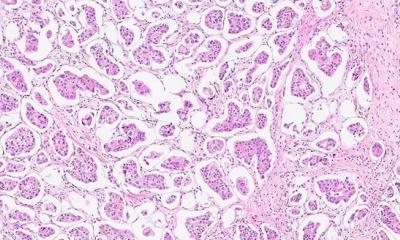Article • AI introduction into clinical workflows
The rocky (but worthwhile) road to digital pathology
Close liaison between pathologists and data scientists is pivotal in the successful introduction of digital pathology and artificial intelligence (AI) into clinical workflows, according to one of France’s leading pioneers in the field.
Report: Mark Nicholls
Professor Catherine Guettier outlined the advantages of digital pathology to the 8th Digital Pathology and AI Congress in London at the beginning of December, but also highlighted obstacles and difficulties, particularly when coupling AI projects with the transition process. She discussed the experiences of creating a single department of digital pathology for three hospitals in the Saclay University hospital group in Paris – a transition in which it was important to acknowledge the demands placed on data scientists.
This is the meeting of the two worlds: of the pathologist and the data scientist
Catherine Guettier
For many pathologists, the transition towards digital pathology and AI is marked with mixed feelings, Guettier observed. The Professor of Pathology at Paris-Saclay University and Head of the Department of Pathology at the Hôpitaux Universitaires Paris-Sud illustrated the challenges of this process by example of her department in her presentation ‘Artificial Intelligence and the pathologist’. Main topics of the session were the work with data scientists, and the new role of digital slides in healthcare data. ‘Pathologists’ expectations include screening of lesion patterns in frequent samples, quantification of tumour cells, mitosis count, automated scoring of cancers, quantification of cellular biomarkers and also beyond the usual task of the pathologist, prognosis, theranostic or molecular prediction.’ Guettier also pointed out the difficulties data scientists face, such as the large dimension of digital slides; difficulties to obtain large enough, balanced and annotated sets; pre-analytic variability; and the issue of interpretability.

Image source: private
Looking at the practicalities of creating a single department of pathology for the Saclay University hospital group, the expert explained how AI projects have been integrated into the transformation process. ‘I am convinced most pathologists will be using AI in their practice,’ she said. ‘But this is the meeting of the two worlds: of the pathologist and the data scientist.’
The new digital pathology network covers three hospitals in Paris, with a shift in focus from teaching to full digital pathology in the workflow. In this constellation, AI has become an important component from the outset. Implementation of the new technology has opened new automation possibilities, for example in quantification of epidermal nerve fibres; screening of prostate and breast cancer foci; and screening of colonic polyps.
Some of the difficulties and obstacles in implementing AI arise from the fact that, currently, very few pathology departments in France are digital. Issues range from lack of compatibility in digital slide sharing between hospitals, different AI companies or academic structures, to regulation issues, medical time for annotation, and GDPR constraints. Prof Guettier said: ‘Digital pathology requires the participation of the pathologist – and many pathologists are already participating – but challenges remain in implementation of AI algorithms into routine workflow.’

High investment, high benefits
As the impact of AI in pathology is not yet clear, implementation of the technology is still lacking a viable business model. This means that managers and pathologists need to work closely to find a financially acceptable solution for hospitals, the expert explained.
This aspect should not be underestimated, Guettier pointed out, because the inclusion of AI comes with the need for considerable investments: Solutions to tackle 30,000 cases per year are priced around the million-euro-mark, with an additional 100,000 euros for maintenance, software upgrades and an imaging engineer. However, these expenses must be carefully weighed against the expected benefits of AI in pathology, especially time savings and improved diagnostic quality. ‘These benefits include sparing technician time for distribution of glass slides, cost savings on microscopes and glass slide storage, earlier and faster second opinion request, and productivity improvement through organisation of pathology labs and telework,’ the expert said. ‘The role of the pathologist in this is to guide the choice of algorithms to be deployed, to provide annotated digital slides, to clinically validate algorithms, to test the implementation of AI algorithms in the digital workflow, and to be customers of AI companies’, she concluded.
Profile:
Catherine Guettier is Professor of Pathology at Paris-Saclay University and is also Head of the Department of Pathology Hôpitaux Universitaires Paris-Saclay – Assistance publique – Hôpitaux de Paris (AP-HP). A pioneer of digital pathology in France, her expertise is in liver pathology and her department and team collaborates with several companies and academic structures for the development of AI-based algorithms in pathology.
03.03.2022










